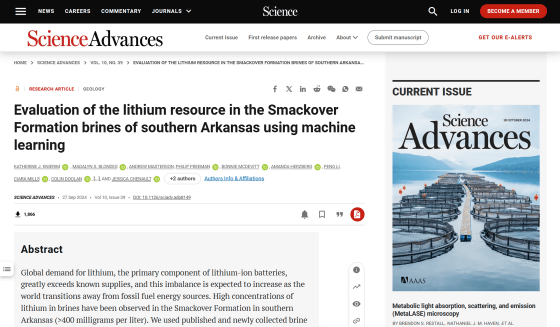Arkansas, USA, may have 5 to 19 million tons of lithium, a metal used in EV and smartphone batteries

Evaluation of the lithium resource in the Smackover Formation brines of southern Arkansas using machine learning | Science Advances
https://www.science.org/doi/10.1126/sciadv.adp8149

Unlocking Arkansas' Hidden Treasure: USGS Uses Machine Learning to Show Large Lithium Potential in the Smackover Formation | US Geological Survey
https://www.usgs.gov/news/national-news-release/unlocking-arkansas-hidden-treasure-usgs-uses-machine-learning-show-large
In recent years, the demand for lithium, an essential component of lithium-ion batteries, has been increasing worldwide, and is predicted to continue to increase as the transition from fossil fuels to renewable energy continues.
Lithium is a substance that is widely distributed throughout the world, but at the time of writing, the main producing countries are Australia, Chile, China, Argentina, Brazil, etc. Although the United States also has lithium deposits, at the time of writing, the United States relies on imports for more than 25% of the lithium it uses.
Geologists from the USGS and the Arkansas Department of Energy and Environment recently conducted a joint study to estimate how much lithium is present in a geological formation in Arkansas called the Smackover Formation .
The Smackover Formation is a limestone layer dating back to the Jurassic ocean, and is known for its abundance of oil and bromine . In recent years, the saltwater extracted from the Smackover Formation has attracted attention for its high concentration of lithium, but the exact amount of lithium present in the Smackover Formation had not been estimated until now.

The team measured lithium concentrations in brine samples taken from across Arkansas, including the Smackover Formation, and compared the data with samples previously collected by the USGS. They then combined these samples with a range of geological data to develop a machine learning model that continuously predicts lithium concentrations across sample-poor areas.
Using a predictive model to create a lithium concentration map of the Smackover Formation, the amount of lithium in the brine of the Smackover Formation was estimated to be 5 to 19 million tons. This amount is equivalent to 35 to 136% of the estimated lithium resources in the United States at the time of writing, and is more than four times the International Energy Agency's (IEA) forecast for 'lithium demand for EVs in 2030.'
'We estimate that there is enough dissolved lithium in the Smackover Formation in Arkansas to replace America's lithium imports,' said hydrologist Catherine Knierim , lead author of the paper, but noted that this is merely a study to estimate reserves. It is important to note that the amount that can be technically recovered is not estimated based on the method of actually extracting lithium from saltwater.
'Lithium is a critical mineral for the energy transition, and the potential for increased U.S. production to displace imports has implications for jobs, manufacturing and supply chain resilience,' said USGS Director David Applegate. 'This study demonstrates the value of science in addressing an economically important problem.'
Related Posts:
in Science, Posted by log1h_ik







